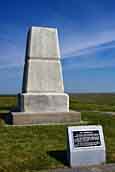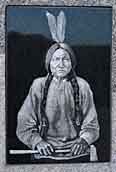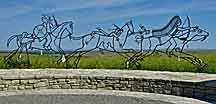|
Scenic USA - Montana Little Bighorn Battlefield Monument |

| Photos by Ben Prepelka Ben Prepelka Photography |
One of Americaís most famous battles of the Plains Wars recalls Custerís poorly planned  advancement into a huge camp of Cheyenne, Lakota (Sioux) and Arapahoe. Often recounted as Custerís Last Stand, the 7th Cavalry encountered at least 1,500 warriors. Custer and all 262 soldiers were killed, sending a shock wave throughout America. This surprising coup along the Little Bighorn River convinced U.S. Government troops to be more cautious. The military followed and harassed the Lakota for five more years, finally forcing most of the remaining Indians onto the Great Sioux Reservation. Sporadic resistance continued until the 20th Century, when brutal tactics eventually sapped the Native Americanís will.
advancement into a huge camp of Cheyenne, Lakota (Sioux) and Arapahoe. Often recounted as Custerís Last Stand, the 7th Cavalry encountered at least 1,500 warriors. Custer and all 262 soldiers were killed, sending a shock wave throughout America. This surprising coup along the Little Bighorn River convinced U.S. Government troops to be more cautious. The military followed and harassed the Lakota for five more years, finally forcing most of the remaining Indians onto the Great Sioux Reservation. Sporadic resistance continued until the 20th Century, when brutal tactics eventually sapped the Native Americanís will.
Nearly a 150 years have  passed since the Great Sioux War and President Grantís attempt to control nomadic Native Americans who roamed throughout the Yellowstone and Powder river valleys. In 1991, President George Bush signed into law a change in name for the Little Bighorn Battlefield National Monument, no longer focusing complete attention on Lt. Col. George A. Custer and his troops. Today, the park encourages peace among all races with a theme of peace through unity. The Indian Memorial at this national monument is contained in a circular earthwork not far from the 7th Calvary Monument.
passed since the Great Sioux War and President Grantís attempt to control nomadic Native Americans who roamed throughout the Yellowstone and Powder river valleys. In 1991, President George Bush signed into law a change in name for the Little Bighorn Battlefield National Monument, no longer focusing complete attention on Lt. Col. George A. Custer and his troops. Today, the park encourages peace among all races with a theme of peace through unity. The Indian Memorial at this national monument is contained in a circular earthwork not far from the 7th Calvary Monument.
Dedicated in 2003, the Spirit Gate Memorial now offers a symbolic remembrance of the Spirit Warriors. Blending in with wavy fields of prairie grass, the memorial follows a theme of Peace through Unity. Standing 75 feet from the 7th Cavalry  Monument, the Spirit Gate Window offers a clear view of the 7th Calvary obelisk. Symbolically, the Spirit Gate Memorial welcomes the 7th Calvary into the memorial circle. Sacred to many Indian tribes, the circle is often part of ceremonial events. This circle's walls are lined with panels for each tribe that fought in the battle. The Crow, Cheyenne, Arapaho, Sioux and Arikara are all represented. Water trickling from the Weeping wall depicts tears shed for both warriors and soldiers.
Monument, the Spirit Gate Window offers a clear view of the 7th Calvary obelisk. Symbolically, the Spirit Gate Memorial welcomes the 7th Calvary into the memorial circle. Sacred to many Indian tribes, the circle is often part of ceremonial events. This circle's walls are lined with panels for each tribe that fought in the battle. The Crow, Cheyenne, Arapaho, Sioux and Arikara are all represented. Water trickling from the Weeping wall depicts tears shed for both warriors and soldiers.
Area Map

|
Nearby Points of Interest |
|
Copyright © 2023 Benjamin Prepelka
All Rights Reserved
